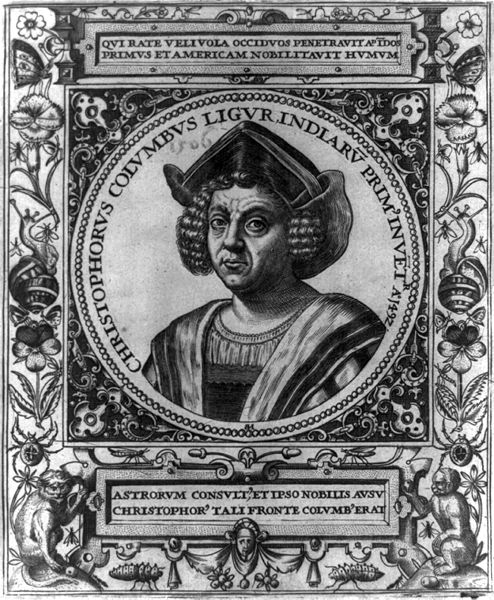1494, September 1~14: Columbus sees a Sea Monster
Christopher Columbus, as drawn by Theodore de Bry in 1590 [Larger version here]
Christopher Columbus [1451-1506] is the man primarily responsible for the continent of Europe discovering the existence of the continents of the Americas, a fact that he has been both celebrated and denigrated for... but I'm not here to argue one way or the other on that historic event. Rather, I'm here to examine something about Columbus' history that is very rarely mentioned by anyone, whether they like him or hate him.
One of the most respected biographies of the 15th Century explorer was written by his son, Ferdinand Columbus [1488-1539]. Ferdinand had personally sailed with his father on Columbus's fourth voyage to North America, in 1502-1504. Ferdinand's manuscript of his father's life, though written after his father's death in 1506, wasn't published until 1571, after Ferdinand's own death in 1539. The book was first published in Italian and was titled "Vita & de' fatti dell' Ammiraglio D. Christoforo Colombo [Life & Deeds of Admiral Christopher Columbus]," and it's now largely from Ferdinand's biography of his father that much of the history of Christopher Columbus and his voyages are known. It is not overstating it to call this book the cornerstone of history about the explorer... which is why it's interesting that the following excerpt from the book gets no attention.
From a modern English translation of Ferdinand's biography, we read that some time between September 1~14 in 1494, during Columbus' second voyage to the Americas, the following curious event occurred:
"Holding on their course, the ship's people sighted a large fish, big as a whale, with a carapace like a turtle's, a head the size of a barrel protruding from the water, a long tail like that of a tunny fish, and two large wings. From this and from certain other signs the Admiral [Columbus] knew they were in for foul weather and sought a port where they might take refuge."
As far as I know, no such creature exists. So what did Columbus and his crew see?
Did It Happen...?
This is one of those moments where the gray zone of what is considered history and what is considered not history is fully exposed.
History is often just stories that have been agreed upon and accepted by historians, with no hard evidence past this agreement to support it... and in the case of most of Christopher Columbus' voyages, this is the case. Ferdinand's account of his father's life is taken as authoritative on many details that no other document can confirm; yet the story above is quietly ignored, even though it has the same amount of evidence to support it as anything else in Ferdinand's biography.
In short, the story above is ignored because current learned thought does not admit to the possibility of an unknown creature in the ocean... but many other details in Ferdinand's biography are accepted because they do agree with modern learned thought about what could be true.
All of which begs the question: what if Columbus actually saw the creature described?
And that, at it's heart, is the difference between history and not history, as well as what's normal and paranormal... what current learned thought allows, no matter what was actually reported.
Anomalies -- the Strange & Unexplained, as well as my other website -- Monsters Here & There -- are supported by patrons, people like you! All new Anomalies articles are now posted for my patrons only, along with exclusive content made just for them. You can become a patron for just $1 a month!
|









